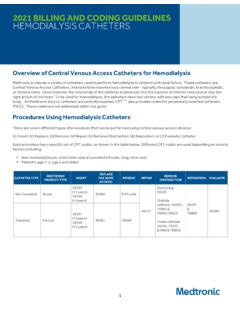Transcription of Dialysate Composition in Hemodialysis and Peritoneal Dialysis
1 Dialysate Composition in Hemodialysis and Peritoneal Dialysis Biff F. Palmer T. he goal of Dialysis for patients with chronic renal failure is to restore the Composition of the body's fluid environment toward normal. This is accomplished principally by formulating a Dialysate whose constituent concentrations are set to approximate normal values in the body. Over time, by diffusional transfer along favorable concentration gradients, the concentrations of solutes that were initially increased or decreased tend to be corrected.
2 When an abnormal electrolyte concentration poses immediate danger, the Dialysate concentration of that electrolyte can be set at a nonphysio- logic level to achieve a more rapid correction. On a more chronic basis the Composition of the Dialysate can be individually adjusted in order to meet the specific needs of each patient. Dialysate Composition for Hemodialysis In the early days of Hemodialysis , the Dialysate sodium concentration was deliberately set low to avoid problems of chronic volume over- load such as hypertension and heart failure.
3 As volume removal became more rapid because of shorter Dialysis times, symptomatic hypotension emerged as a common and often disabling problem dur- CHAPTER. ing Dialysis . It soon became apparent that changes in the serum sodium 2. concentration and more specifically changes in serum osmolality . were contributing to the development of this hemodynamic instability. A decline in plasma osmolality during regular Hemodialysis favors a Dialysis as Treatment of End-Stage Renal Disease fluid shift from the extracellular space to the intracellular erbate hemodynamic instability during the Dialysis procedure [21].
4 In this regard, the intradialysis drop in blood pressure space, thus exacerbating the volume-depleting effects of dialy- noted in patients dialyzed against a low-calcium bath, while sis. With the advent of high-clearance dialyzers and more effi- statistically significant, is minor in degree [22,23]. Nevertheless, for patients who are prone to intradialysis hypotension avoid- cient Dialysis techniques, this decline in plasma osmolality ing low calcium Dialysate concentration may be of benefit. On the other hand, the use of a lower calcium concentration in the becomes more apparent, as solute is removed more rapidly.
5 Dialysate allows the use of increased doses of calcium-containing phosphate binders and lessens dependence on binders containing Use of Dialysate of low sodium concentration would tend fur- aluminum. In addition, use of 1,25-dihydroxyvitamin D can be ther to enhance the intracellular shift of fluid, as plasma tends liberalized to reduce circulating levels of parathyroid hormone and, thus, the risk of inducing hypercalcemia. With Dialysate to become calcium concentrations below mmol/L, however, patients need close monitoring to ensure that negative calcium balance even more hyposmolar consequent to the movement of sodi- does not develop and that parathyroid hormone levels remain um from in an acceptable range [24].
6 Plasma to Dialysate . The use of a higher sodium concentration Dialysate Composition for Peritoneal Dialysis To meet the ultrafiltration requirements of patients on Peritoneal Dialysate (>140 mEq/L) has been among the most efficacious Dialysis , the Peritoneal Dialysate is deliberately rendered hyper- and best tolerated therapies for episodic hypotension [1 3]. osmolar relative to plasma, to create an osmotic gradient that favors net movement of water into the Peritoneal cavity. In The high sodium concentration prevents a marked decline in commercially available Peritoneal dialysates, glucose serves as the osmotic agent that enhances ultrafiltration.
7 Available con- the plasma osmolality during Dialysis , thus protecting the extra- centrations range from to dextrose. Over time, the cellular volume by minimizing osmotic fluid loss into the cells. osmolality of the Dialysate declines as a result of water moving In the early 1960s acetate became the standard Dialysate into the Peritoneal cavity and of absorption of Dialysate glucose. buffer for correcting uremic acidosis and offsetting the diffusive The absorption of glucose contributes substantially to the calorie losses of bicarbonate during Hemodialysis .
8 Over the next several intake of patients on continuous Peritoneal Dialysis . Over time, years reports began to accumulate that linked routine use of this carbohydrate load is thought to contribute to progressive acetate with cardiovascular instability and hypotension during obesity, hypertriglyceridemia, and decreased nutrition as a Dialysis . As a result, Dialysate containing bicarbonate began to result of loss of appetite and decreased protein intake. In addition, re-emerge as the principal Dialysate buffer, especially as advances the high glucose concentrations and high osmolality of currently in biotechnology made bicarbonate Dialysate less expensive and available solutions may have inhibitory effects on the function less cumbersome to use.
9 For the most part, the bicarbonate con- of leukocytes, Peritoneal macrophages, and mesothelial cells centration used consistently in most Dialysis centers is 35 [25]. In an attempt to develop a more physiologic solution, various mmol/L. Emphasis is now being placed on individually adjusting new osmotic agents are now under investigation. Some of these the Dialysate bicarbonate concentration so as to maintain the may prove useful as alternatives to the standard glucose solutions. predialysis tCO2 concentration above 23 mmol/L [12 16].
10 Those that contain amino acids have received the most attention. Increasing evidence suggests that correction of chronic acidosis The sodium concentration in the ultrafiltrate during peri- is of clinical benefit in terms of bone metabolism and nutrition. toneal Dialysis is usually less than that of extracellular fluid, so Dialysis assumes a major role in the maintenance of a normal there is a tendency toward water loss and development of hyper- serum potassium concentration in patients with end-stage renal natremia.




